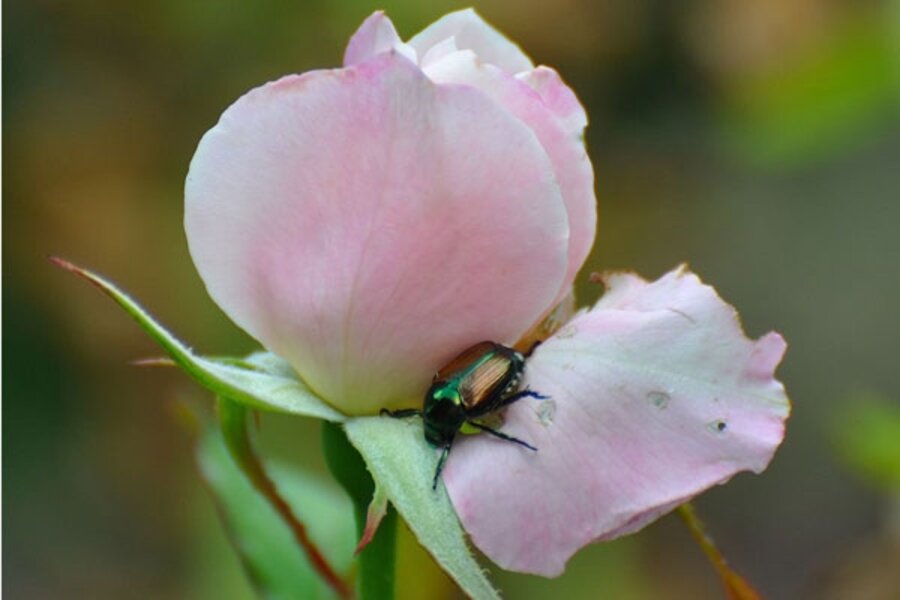The Rose Whisperer: Meet the beetles
Loading...
If the invasion hasn’t already hit your yard, rest assured that in many parts of the country, it will be starting shortly. Those little whispers of “Tora, Tora, Tora” you may hear while walking through the garden are warnings that adult Japanese beetles (Popillia japonica) are emerging from the ground, ready to attack more than 300 different species of trees and shrubs, ornamental plants, and flowers.
I know because yesterday morning while looking for beetles to photograph, I found only one. Then, four hours later, dozens were feasting on some of their favorite victims, my light-colored roses. Blooms of Pristine, Cottage Rose, and First Kiss won’t be the only fatalities because soon they’ll also be snacking on hollyhocks, sweet peppers, Japanese maples, and crape myrtles. These eating machines even like poison ivy ivy although they don’t control it since the vine grows mostly in shade and beetles prefer to stay in the sun.
Japanese beetles were first discovered in a New Jersey nursery in 1916, possibly having stowed away in a shipment of iris bulbs. By 1930, the beetles had traveled across almost 6,000 square miles in New Jersey, Pennsylvania, and Delaware. Today, the pests are established in 30 states and continue to spread at a rate of five to 10 miles per year. Today, according to Michael Klein, adjunct professor of entomology at Ohio State University, there are only a few states in the lower 48 that do not have beetle problems. Their natural spread of five to 10 miles a year has been aided by the movement of nursery stock.
As adult beetles reach the soil's surface, they crawl or fly to low growing plants and begin to feed. The first ones to break ground release an odor (pheromone) that attracts other adults, and party time begins in earnest.
The females live about 45 days and can lay up to 60 eggs each, generally under grass roots in lawns. Within a few weeks, the eggs will hatch into grubs with voracious appetites. They munch on grass roots and can devastate a yard. In fact, according to the University of Florida Extension Service, Japanese beetles cost the turf and ornamental industry approximately $450 million a year.
When cold weather settles in, the grubs move deeper into the soil. In spring, they again feed on grass roots until pupation in late May. The adults emerge with brilliant metallic green bodies and hard, copper-colored wing covers to start the assault all over again.
So do we just raise the white flag and watch our favorite summer plants fight a losing battle? In their homeland, native predators keep beetle numbers in check. Not so in America. Adult beetles have few enemies -- they aren’t tasty fare for birds although grackles, starlings, cardinals, redwing blackbirds, and robins do feed on grubs. (Ducks like them, too.)
As a natural control, picking beetles by hand is safe but not very effective. Shake them into a pail of soapy water and they’ll eventually drown.
Don’t ever crush a beetle – as a dying insult it will release more pheromone and attract even more pests.
Milky spore is a bacterial disease harmless to humans and animals that kills grubs.Apply it to grassy areas of the yard, but it takes two to three years to become effective. Neem oil, insecticidal soaps, and sprays containing garlic have also been recommended. High-value plants can be protected with spun polyester covers such as Reemay.
Research done at the University of Kentucky shows that commercial traps may attract more beetles than are actually caught. If you are determined to use traps, place them at least 30 yards away from plants you want to protect.
If you choose to bring out the heavy artillery and spray with insecticides, consult your local Agricultural Extension Service office for recommendations. Keep in mind that some kill beneficial insects and must be used with care in areas frequented by children, pets, and wildlife.
I try to avoid the scorched earth theory of bug control and use a combination of spot pruning and insecticidal soap to limit the damage. I’ve also heard that beetles can be confused by the scents of garlic, mint, chives, catmint, basil, and onions. These companion plantings can’t hurt, and certainly might help in our struggle to bid sayonara to a determined enemy.
PSSST: Each year a new urban legend about beetle control pops up on the Internet. This year’s tip is to spritz individual beetles with plain old window cleaner. I haven’t tried it yet. Dr. Klein says that depending on the cleaner’s ingredients, it just might do a beetle in.
He also says the heavy rains this spring could mean bigger populations next year. So let me know what works for you so we can be well armed for the invasion of 2010.
Editor's note: To read more by The Rose Whisperer, click here to access our blog list. For more garden articles – at least one new one each weekday – click here. Click here for the RSS feed of all our gardening content.





